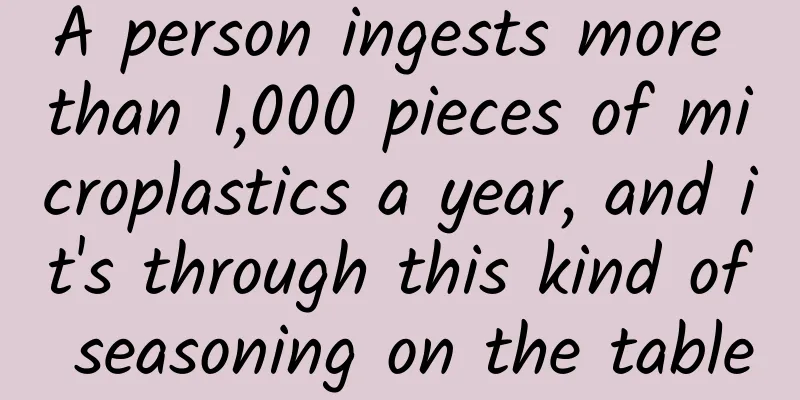A person ingests more than 1,000 pieces of microplastics a year, and it's through this kind of seasoning on the table

|
Climate warming, environmental pollution...our planet is changing quietly. However, among all these changes, there is one change happening on Earth that most people are not aware of: the Earth is slowly becoming saltier. Recently, Professor Sujay Kaushal of the University of Maryland and researchers from related institutions published a paper in the British journal Nature Reviews Earth and Environment, pointing out that the natural "salt cycle" is mainly driven by relatively slow geological and hydrological processes, which bring different salts to the earth's surface; while human activities such as mining, land development, and agricultural production have contributed to the artificial "salt cycle", affecting the concentration and circulation of salt on a global scale. If this trend continues, it may pose an "existential threat" to humans. Workers making salt (Image source: pixabay) Everything has already shown signs When was it discovered that the Earth was becoming saltier? In fact, the signs of this had already appeared as early as eight or nine years ago. In June 2015, a neighbor of Sujay Kaushal, a geology professor at the University of Maryland, asked him the same question as a Washington Post reporter: "Have you noticed that the water near us has turned brown?" In fact, Kaushal not only noticed it, but also knew very well that the reason for the color change of the water here was the salt in the groundwater. "The salt content in the groundwater is so high that it corrodes the old cast iron pipes in these areas, causing manganese and copper from the pipes to enter the water and contaminate the water source," he said. Under natural conditions, there is a natural flow and circulation of salt on Earth. A large amount of salt exists in the form of minerals in the Earth's rocks. Over a long period of time, when these rocks are exposed to the surface and weathered and eroded, the salt will be slowly released. These salts will be accompanied by water flow, through organisms, groundwater, soil and oceans, and eventually re-formed into rocks and buried underground. Schematic diagram of the Earth's salt cycle "Just like your doctor will warn you to be careful about high blood pressure after eating too much salt, if you think of the Earth as a whole living organism, then when so much salt accumulates, it may also affect the functioning of important organs or the ecosystem," said Kaushal. It can be seen that the salt cycle on Earth is vital to the ecosystem and human survival. Salt How does Earth's salt affect us? The first thing that must be mentioned is soil salinization. Statistics show that about 1 billion hectares of soil are affected by human-induced salinization, which is mainly related to irrigation water, fertilization and lime use. According to estimates, by the end of the 21st century, more than 50% of the world's farmland may be affected by salinization. Soil salinization Research shows that soil salinization is the main factor limiting plant growth and development, and also poses a great challenge to agricultural production. Currently, the annual crop production loss related to saline-alkali environment is between 18% and 43%. Due to soil salinization, the food problems that may arise in the future have to arouse people's vigilance. But what worries researchers even more is that when salt ions dissolve in water, they can "mobilize" many pollutants into the water, eventually forming a mixture of pollutants - what the Kaushal research team calls a "pollutant cocktail." The water that turned brown at the beginning of the article is a typical example. Especially in areas with old pipes, overly salty water can corrode pipes, allowing metals such as manganese and copper to enter the water lines. The positively charged sodium ions carried by these highly saline waters can destroy clay and organic matter that have absorbed many pollutants, thereby releasing the pollutants and causing water pollution. Water pollution will inevitably affect the "pond fish". This "pond fish" is salt. Scientific American reported a study by East China Normal University in Shanghai: Microplastics, such as polyethylene and cellophane, were found in 15 brands of salt samples collected by researchers, especially sea salt, which contained more than 550 per kilogram. They made a calculation: based on the amount of salt we consume every day, a person may ingest more than 1,000 pieces of microplastics through salt in a year. Salt for human consumption (Image source: pixabay) "The death rate among Chinese people due to excessive salt intake ranks first in the world. Excessive salt intake has become an important factor endangering the health of our residents." Professor Ma Guansheng, director of the Department of Nutrition and Hygiene at the School of Public Health of Peking University, said at the New Year's Eve science popularization event of the "Power of Communication" of the China Health Knowledge Communication Incentive Program on December 29, 2023. This shows that the salt used by humans is invisibly poisoning ourselves. So, how can these situations be alleviated? Kaushal regretted that "today, salt is not considered a major drinking water contaminant, so it is difficult to regulate it." Faced with this situation, all we can do is to reduce the natural "salt cycle" caused by human factors to reduce the "existential threat" posed by the saltier earth to mankind. |
Recommend
What is the difference between underwear that costs 20 yuan and underwear that costs 200 yuan?
Underwear plays an important role in shaping wome...
The book-writing brother Weibo follower training camp, how to write high-conversion likes to increase followers, how to go from 0 followers to more than 50,000
The book-writing brother Weibo follower training ...
Taiyang's new course in 2021: Love Maker
Taiyang's new course in 2021: Love Maker Taiy...
How do Internet finance platforms retain users?
Although new media operations cannot effectively ...
When operating short videos, don’t fall into these pitfalls!
People often say "avoiding pitfalls is progr...
Honda China: Honda China's terminal sales of automobiles in October 2024 will be 75,400 units, with cumulative sales in the first 10 months down 31% year-on-year
Recently, according to domestic media reports, Ho...
"WHO reminds people to avoid using ibuprofen when dealing with COVID-19?" Don't be misled by outdated information!
Recently, a piece of news released in 2020 has on...
Dear advertiser, what misunderstanding do you have about advertising creativity?
A few days ago, a colleague sent me an App screen...
Antibiotics and anti-inflammatory drugs, what is the difference? Many people take them wrongly
gossip "Cold, fever, toothache, sore throat,...
Comparison of the five major smartphone systems to see which one is stronger
Smartphones are mobile phones with more powerful ...
Can drinking bone soup really supplement calcium?
In the topic of children's growth and develop...
"Nezha 2" has exceeded 10 billion box office! These three types of people are not recommended to watch the 3D version
Review expert: Peng Guoqiu, deputy chief physicia...
Take the example of collecting five blessings: How to plan a super marketing campaign?
What is super marketing? [Super Marketing] is the...
Hanjia Army 2021 First Quarter Practical Sharp Knife Class 8 Documents
Brief introduction to the document resources of H...









